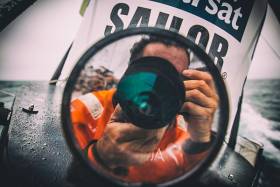Displaying items by tag: Onboard Reporter
If you died tomorrow, could you say you truly lived your life to the full?
That’s the question the Volvo Ocean Race is posing in its new online campaign as it bids to discover the next batch of brave Onboard Reporters willing to tackle the world’s most famous offshore challenge in 2017-18.
Dubbed ‘the toughest job in sports media’, it’s a unique role that certainly isn’t for the faint-hearted. No other sport features dedicated multimedia journalists embedded within teams of athletes and prospective candidates will have to survive a creative ‘boot camp’ proving their ability to stand the mental and physical pressure of the role, before being accepted.
The event, which since 1973 has pitted the best professional sailors on the planet against each other over 40,000 nautical miles, covering four oceans, five continents and nine marathon months, requires multi-skilled and experienced media professionals to join the crews onboard and report back to shore from the most remote and hostile regions on the planet.
“For a professional storyteller, I’m certain that there’s no greater challenge on earth than this,” explains American filmmaker Amory Ross, who has performed the role in the last two editions of the race.
“You are pushed far beyond your physical, mental and creative limits in a way that can compare with little else.”
To push content from the world’s oceans to race fans takes some serious technology. Every boat is fitted with state-of-the-art equipment, remote-control cameras, microphones and custom-designed media stations.
Cutting-edge communications support, provided by Inmarsat since 2005, delivers daily multimedia content to serve a global audience of tens of millions - via high-speed satellites - from each of the super-charged 65-foot racing boats while at sea.
The ideal candidates to join the elite storytelling squad will be capable of producing high-quality video, photo and written content on a daily basis, whatever the conditions.
“We’re looking candidates with an adventurous streak, but also with a history of solid media experience, an eye for a shot and a nose for a story,” explains Leon Sefton, who is leading the OBR recruitment project and is Head of Television at the Volvo Ocean Race.
“It cannot be underestimated how tough this role is to perform, day in, day out, in boat-breaking conditions and with little to no sleep.”
Over 2,000 hopefuls applied for the position in the last edition in 2014-15, and organisers are expecting an even bigger number of applications this time around.
The work of the Volvo Ocean Race Onboard Reporters is regularly featured across some of the world’s most recognisable media outlets, such as The Daily Telegraph, the New York Times, Red Bull Media House and 242 broadcasters on 83 television channels around the globe.
“The Onboard Reporters in the Volvo Ocean Race need to be much more than just a pretty face with a microphone. In fact, they may be performing the toughest job in sports journalism,” wrote award-winning journalist Tim Wendel in a Huffington Post story.
To apply, potential candidates should visit the campaign website, if.volvooceanrace.com, and follow the brief to produce example work.
If selected, they will move through to the next round where a formal interview will take place. Then they will be one step closer to joining the world’s most adventurous media team.
























































